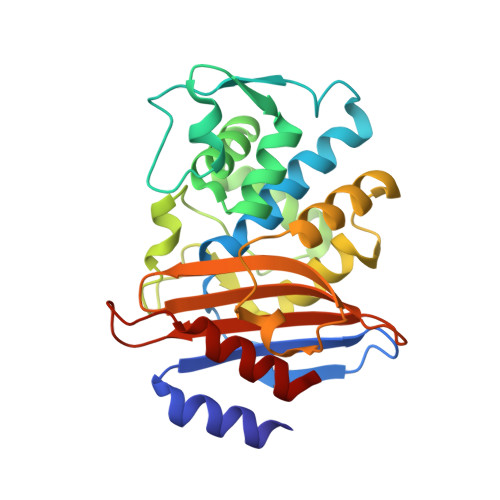Neutron Diffraction Studies of a Class a Beta-Lactamase Toho-1 E166A R274N R276N Triple Mutant
Tomanicek, S.J., Blakeley, M.P., Cooper, J., Chen, Y., Afonine, P., Coates, L.(2010) J Mol Biol 396: 1070
- PubMed: 20036259
- DOI: https://doi.org/10.1016/j.jmb.2009.12.036
- Primary Citation of Related Structures:
2WYX - PubMed Abstract:
beta-Lactam antibiotics have been used effectively over several decades against many types of bacterial infectious diseases. However, the most common cause of resistance to the beta-lactam antibiotics is the production of beta-lactamase enzymes that inactivate beta-lactams by rapidly hydrolyzing the amide group of the beta-lactam ring. Specifically, the class A extended-spectrum beta-lactamases (ESBLs) and inhibitor-resistant enzymes arose that were capable of hydrolyzing penicillins and the expanded-spectrum cephalosporins and monobactams in resistant bacteria, which lead to treatment problems in many clinical settings. A more complete understanding of the mechanism of catalysis of these ESBL enzymes will impact current antibiotic drug discovery efforts. Here, we describe the neutron structure of the class A, CTX-M-type ESBL Toho-1 E166A/R274N/R276N triple mutant in its apo form, which is the first reported neutron structure of a beta-lactamase enzyme. This neutron structure clearly reveals the active-site protonation states and hydrogen-bonding network of the apo Toho-1 ESBL prior to substrate binding and subsequent acylation. The protonation states of the active-site residues Ser70, Lys73, Ser130, and Lys234 in this neutron structure are consistent with the prediction of a proton transfer pathway from Lys73 to Ser130 that is likely dependent on the conformation of Lys73, which has been hypothesized to be coupled to the protonation state of Glu166 during the acylation reaction. Thus, this neutron structure is in agreement with a proposed mechanism for acylation that identifies Glu166 as the general base for catalysis.
Organizational Affiliation:
Neutron Scattering Science Division, Oak Ridge National Laboratory, 1 Bethel Valley Road, Oak Ridge, TN 37831, USA.














